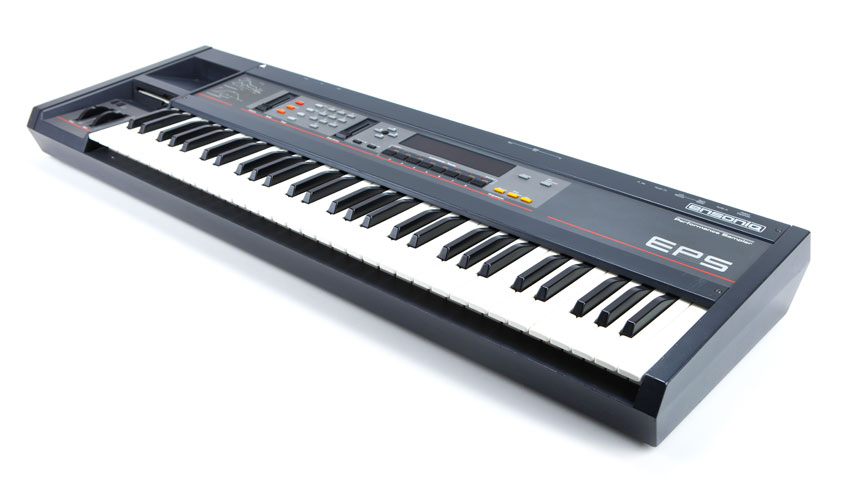Blast from the past: Ensoniq EPS
The Ensoniq Performance Sampler - or EPS - would open up whole new horizons for sampling

US company Ensoniq had a lot to live up to in 1988. Its price-busting Mirage had put sampling into the hands of 30,000 workaday musicians, albeit with rather compromised 8-bit fidelity.
Still, such lo-fi sound was standard when the Mirage was released back in 1985 - after all, E-MU’s own high-end EII was also an 8-bit sampler and cost nearly five times what Ensoniq were charging for the Mirage; and, despite E-MU’s lofty reputation, Ensoniq’s sampler outsold the EII ten times over.
However, by 1988, the Mirage was looking a bit long in the tooth. Roland and Casio both offered sleek 12-bit machines with better display options than the Mirage’s woeful 2-digit hexadecimal display, at prices that, while higher than that of the Mirage, were still considerably cheaper than the Emulators and Fairlights so beloved by the chart-toppers who could afford them.
Clearly, something was needed to build on the momentum created by the Mirage, and maintain Ensoniq’s new rep as an innovative company.
Enter the Ensoniq Performance Sampler, or EPS. The EPS shared a design basis with the company’s now-classic ESQ-1 wavetable synth, with a big, bright vacuum fluorescent display, and bulky, angular plastic casing. However, it earned the ‘Performance’ in its moniker by allowing samples to be loaded while the user was playing other samples from its keyboard.
That keyboard, by the way, could respond to said aftertouch polyphonically - a rarity even today. Additionally, two ‘patch select’ buttons above the pitch and mod wheels allowed for instant access to three variations on the currently loaded patch.
That keyboard, by the way, could respond to said aftertouch polyphonically - a rarity even today.
Sample memory was meagre, with 480Kb of stock RAM that could be doubled via optional memory expander. Sample times ranged from 5 to 41 seconds, depending on the selected sample rate, which, incidentally, could be pushed all the way up to 52kHz or plumbed to a low 6.25kHz.
Want all the hottest music and gear news, reviews, deals, features and more, direct to your inbox? Sign up here.
Unusually, the EPS was a 13-bit sampler, and as such has become beloved for its ability to impart a crunchy, gritty sound when the system was artfully abused.
Samples could be manipulated in a number of ways. A multitude of looping options were offered, and loop points could be modulated. A design flaw caused random bits of sample memory to be randomly played when loop points were set too close together. A literal glitch machine, then!
The Mirage’s lovely analogue filters were replaced with multimode, non-resonant digital jobs. LFOs with a wide variety of waveforms were included, as were six-stage envelope generators. Interestingly, the EPS allowed users to modulate between two different envelope shapes - one for soft and another for hard velocities.
The EPS’ 16-track sequencer could record and play back up to 80,000 notes. Extensive editing options made the EPS’ sequencer feel more like a computer-based software sequencer than most.
The EPS would eventually give way to the EPS 16-Plus, a 16-bit sampler with built-in effects and wavetable synthesis functions. Today, both models are recognised for their sound quality - or lack thereof.
Secondhand models are risky - the EPS was notorious for its instability. Still, they remain inexpensive and are still worth a play, even if only to add a bit of grit to your tracks.
Three great plugin alternatives

Togu Audio Line TAL-Sampler
TAL-Sampler doesn’t specifically emulate the EPS, but it does successfully capture the sound and experience of working with classic old-school samplers. Its Vintage DAC modes and variable sample rates can get you very close indeed to the classic, degraded sound of an EPS with the sampling rates cranked down. A good buy.
Read more about Togu Audio Line TAL-Sampler

112dB Morgana
While you may not find a dead-on emulation of the EPS anywhere, there is this nifty software sampler inspired by its predecessor, the Mirage. Here, 8-bit sampling is coupled with variable sampling rates that go up to a near-EPS high of 50kHz, plus modelled sampling input with modelled anti-aliasing filter, used by Ensoniq to tailor high frequencies for better sampling.
Read full 112dB Morgana review

Siegfried Kullmann SQ8L
This plugin for Windows is almost old enough to qualify for its own Blast from the past! SQ8L emulates the EPS’ synthesiser stablemate, the Ensoniq SQ-80. As such, it does offer some noteworthy similarities to the EPS’ interface. The sound is closer to that of a Mirage, though, with its resonant filters and 8-bit grit.


Computer Music magazine is the world’s best selling publication dedicated solely to making great music with your Mac or PC computer. Each issue it brings its lucky readers the best in cutting-edge tutorials, need-to-know, expert software reviews and even all the tools you actually need to make great music today, courtesy of our legendary CM Plugin Suite.
